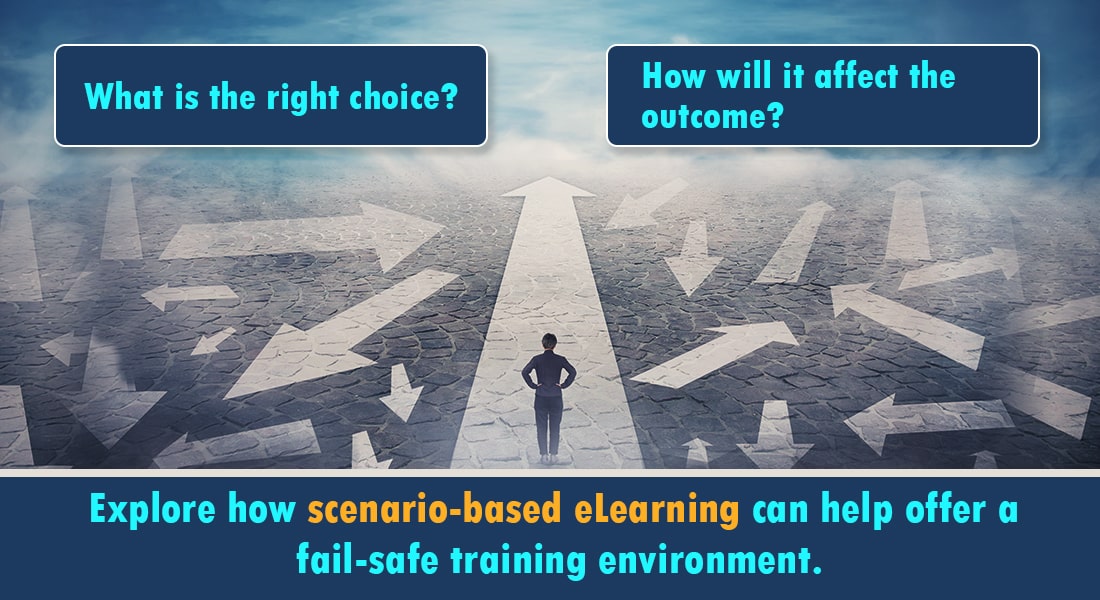A Training Manager’s Guide to Scenario-based eLearning

What is Scenario-based eLearning?
Scenario-based eLearning is an approach to training that offers learners simulated, interactive, problem-based contexts and promotes active learning. It offers interactive learning experiences ensuring employees are equipped to deal with similar situations at work and generally works best for training adults on gray areas – where they need to interpret knowledge and take decisions.
Join this webinar for insights on the types of scenarios, best practices for scenario-based eLearning, and more.
Benefits of Scenario-based eLearning
- Provide a risk-free environment to learn, avoiding costly repercussions and delays
- Help learners empathize and see how their decisions/choices affect others
- Help learners apply their prior experience, subject knowledge, critical thinking
- Ideal to train on gray areas and sensitive topics
Scenario-based eLearning offers sticky learning with immediate feedback to learners in realistic situations they need to face. When learners find themselves in a scenario and solve it using the acquired knowledge or learn through feedback, learning is exponential compared to a normal click-next eLearning.
Benefits of Scenario-based eLearning
- Promote critical thinking and decision-making
- Offer immediate feedback for sticky learning
- Present a safe learning environment
- Get a high training ROI
More about Scenario-based eLearning
When to Use Scenarios in eLearning
Scenario-based eLearning can be used for dry and boring topics such as legal content where it might be difficult for learners to readily see real life application on the job. Scenarios can also be used for soft skills training where often there’s no single correct answer. In such situations, scenario-based learning will help learners analyze situations and determine the best course of action and/or how rules apply.
When NOT to Use Scenarios in eLearning
It is important to understand that despite their efficacy, scenarios don’t work in all eLearning courses. For example, if the course is on processes that involve learners following certain predetermined steps – without any ambiguity – using scenarios will be unnecessary and a cognitive overload for learners. Similarly, scenarios aren’t needed when the course is a basic level eLearning on facts, definitions, and terminology.
Explore a few best practices to design scenario-based eLearning courses in this infographic.
Reasons to use Scenario-based eLearning
The USP of scenario-based eLearning is the storytelling aspect. Stories hook us emotionally, help empathize with the characters, and are great tools to facilitate learning for both new hires and experienced veterans.
1. Promote Critical Thinking and Decision-Making Skills
In scenario-based learning, learners are given real-world problems they are required to resolve. This requires a lot of thinking and decision making to solve the problem. When scenario-based eLearning is used, it equips employees to:
- Understand all likely paths they can choose in that situation
- Consequences of each decision point
- Best decision to resolve the problem
And they can do this in a fail-safe environment, repeatedly – thereby honing their decision-making abilities.
2. Offer Immediate Feedback for Sticky Learning
A scenario-based eLearning course – when designed well – can mirror reality and help employees explore the nuances of each decision/action through immediate feedback instantly. This makes for an impactful learning experience, transferring performance from the computer to the cubicle instantly.
For example, reduced points when a customer leaves a store due to an unhelpful sales rep or a lost life when a co-worker isn’t satisfied with the response in a particular situation make the outcome very clear and feedback can be used to reinforce (a) why the behavior was unsatisfactory (b) the right course of action.
Pro Tip
If the scenarios are complex or difficult to find likely outcomes, instructional designers need to work in consultation with subject matter experts to get the scenarios validated for accuracy and relevancy.
3. Present a Safe Learning Environment
Imagine the situations described above happening in real-life. The least they cause is embarrassment, with loss of revenue & reputation, heavy penalties, damage to property, and more on the extreme end of the spectrum.
Scenario-based eLearning provides learners a safe environment where they can make mistakes, experience the consequences – without the real-time damage – and learn how to avoid them. Scenarios are also a great tool to teach sensitive topics such as sexual harassment and workplace discrimination which might be difficult in a face-to-face setting.
4. Enjoy a High Training ROI
Custom eLearning requires significant investment. This cost needs to be justified by an improvement in employee performance. With their reusability and safe, simulated environment, scenarios will offer you a higher return as learners will be in sync with consequences on the job right from the training period itself.
Some tips to ensure better ROI from scenario-based eLearning:
- Ensure scenarios target learners’ pain points and are realistic with characters and plots they can relate to
- Use authoring tools that offer in-built assets libraries and/or tools
- Align language, settings, and colors with your corporate branding for immediate recall
- Configure user-generated content/success stories of top performers as scenarios
First Among Equals
Ensure you have a blueprint for each scenario – with all possible decision points and their outcomes – to avoid rework which can cause delays.
Parting Thoughts
The next time you want to offer sticky learning, you now know whether scenario-based eLearning is the right choice! Scenarios work well to:
- Validate learning
- Facilitate application of learning
- Enhance critical thinking ability
- Instill confidence
And here’s a bonus for staying with us till the end – scenarios make great assessment tools! Try a course with mini scenarios and push it to learners at regular intervals to refresh their memory. Or microlearning quizzes to test recall; podcasts sharing success stories, or a game-based module with increasing levels of difficulty!
To explore more learning strategies that offer sticky learning, get this webinar recording now.




![How to Describe the Results in Scenario – Based E-learning [Infographic]](https://blog.commlabindia.com/hubfs/Imported_Blog_Media/scenario-based-learning-in-elearning-1.png)

